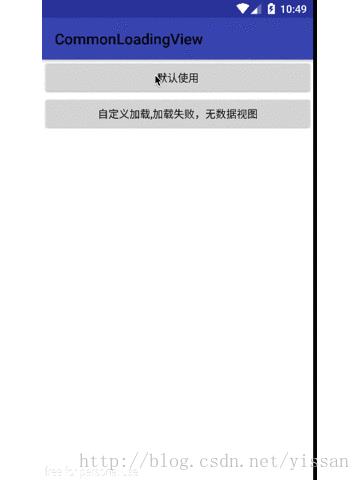LayUi创建一个自定义通用模块
Posted
tags:
篇首语:本文由小常识网(cha138.com)小编为大家整理,主要介绍了LayUi创建一个自定义通用模块相关的知识,希望对你有一定的参考价值。
参考技术A layui自定义模块的好处可以将常见的操作进行封装,降低代码耦合度。封装的两个层次
1、与具体业务无关的封装,比如 某个具体显示效果,字符操作函数 日期操作函数 或者网络请求函数等
2、与具体业务或者说具体的html页面相关的的模块
说明:
var o; 表示是一个对象,getName是其中的一个方法
这样完成了自定义扩展并使用到html页面中。
注:doLoadLayuiModule :是封装layui加载模块的方法,代码如下
Android 自定义通用的loadingview
介绍
好久没有写博客啦,接近新年了,年前的工作都要收尾,所以特别忙,周末抽空写了个通用的加载view,写篇博客分享出来。
功能
1、显示加载视图,加载失败的时候显示加载失败视图,数据为空时显示数据为空视图,支持为失败视图设置点击事件重新加载数据。
2、支持个性化设置,自定义设置 加载、失败、空数据视图。
先放一张效果图压压惊

实现
实现思路其实就是一个FrameLayout里添加三个布局做处理显示隐藏,自定义视图其实就是替换里面的view ,代码比较简单,如果直接看过我的自定义view系列文章,或者对自定义view有所了解,都很容易看懂,所有直接上代码了。
具体代码
java 代码
public class CommonLoadingView extends FrameLayout {
//加载时显示文字
protected TextView mLoadingTextTv;
public Context mContext;
//加载错误视图
protected LinearLayout mLoadErrorLl;
//加载错误点击事件处理
private LoadingHandler mLoadingHandler;
//加载view
private View loadingView;
//加载失败view
private View loadingErrorView;
//数据为空
private View emptyView;
public CommonLoadingView(Context context, AttributeSet attrs) {
this(context, attrs, 0);
}
public CommonLoadingView(Context context, AttributeSet attrs, int defStyleAttr) {
super(context, attrs, defStyleAttr);
mContext = context;
}
public void setLoadingHandler(LoadingHandler loadingHandler) {
mLoadingHandler = loadingHandler;
}
public void setLoadingErrorView(View loadingErrorView) {
this.removeViewAt(1);
this.loadingErrorView = loadingErrorView;
this.loadingErrorView.setOnClickListener(new OnClickListener() {
@Override
public void onClick(View v) {
if (mLoadingHandler != null) {
mLoadingHandler.doRequestData();
CommonLoadingView.this.load();
}
}
});
this.addView(loadingErrorView,1);
}
public void setLoadingView(View loadingView) {
this.removeViewAt(0);
this.loadingView = loadingView;
this.addView(loadingView,0);
}
@Override
protected void onFinishInflate() {
super.onFinishInflate();
loadingView = inflate(mContext, R.layout.common_loading_view, null);
loadingErrorView = inflate(mContext, R.layout.network_layout, null);
emptyView = inflate(mContext, R.layout.empty_layout, null);
this.addView(loadingView);
this.addView(loadingErrorView);
this.addView(emptyView);
loadingErrorView.setVisibility(GONE);
emptyView.setVisibility(GONE);
initView(this);
}
public void setMessage(String message) {
mLoadingTextTv.setText(message);
}
private void initView(View rootView) {
mLoadingTextTv = (TextView) rootView.findViewById(R.id.loading_text_tv);
mLoadErrorLl = (LinearLayout) rootView.findViewById(R.id.load_error_ll);
mLoadErrorLl.setOnClickListener(new OnClickListener() {
@Override
public void onClick(View v) {
if (mLoadingHandler != null) {
CommonLoadingView.this.load();
mLoadingHandler.doRequestData();
}
}
});
}
public void load(){
loadingView.setVisibility(VISIBLE);
loadingErrorView.setVisibility(GONE);
emptyView.setVisibility(GONE);
}
public void load(String message){
mLoadingTextTv.setText(message);
loadingView.setVisibility(VISIBLE);
loadingErrorView.setVisibility(GONE);
emptyView.setVisibility(GONE);
}
public void loadSuccess(){
this.loadSuccess(false);
}
public void loadSuccess(boolean isEmpty){
loadingView.setVisibility(GONE);
loadingErrorView.setVisibility(GONE);
if (isEmpty) {
emptyView.setVisibility(VISIBLE);
}else{
emptyView.setVisibility(GONE);
}
}
public void loadError(){
loadingView.setVisibility(GONE);
loadingErrorView.setVisibility(VISIBLE);
}
public interface LoadingHandler{
void doRequestData();
}
}
使用
基本使用
几个基本的 load loadError loadSucccess方法的使用。
public class DefaultViewActivity extends AppCompatActivity {
protected ListView mListView;
protected CommonLoadingView mLoadingView;
private List<String> mList = new ArrayList<>();
ArrayAdapter adapter;
@Override
protected void onCreate(Bundle savedInstanceState) {
super.onCreate(savedInstanceState);
super.setContentView(R.layout.activity_default_view);
initView();
}
private void initView() {
mListView = (ListView) findViewById(R.id.listView);
mLoadingView = (CommonLoadingView) findViewById(R.id.loadingView);
mLoadingView.load();
//设置点击错误视图重新加载事件
mLoadingView.setLoadingHandler(new CommonLoadingView.LoadingHandler() {
@Override
public void doRequestData() {
mLoadingView.postDelayed(new Runnable() {
@Override
public void run() {
for (int i = 1; i <=20 ; i++) {
mList.add(i+"");
}
adapter = new ArrayAdapter(DefaultViewActivity.this, android.R.layout.simple_list_item_1, android.R.id.text1, mList);
mListView.setAdapter(adapter);
mLoadingView.loadSuccess(false);
}
},2500);
}
});
//模拟网络错误,加载失败
mLoadingView.postDelayed(new Runnable() {
@Override
public void run() {
mLoadingView.loadError();
}
},2500);
}
}自定义视图 使用
只需要把自己自定义的view调用set方法设置进去即可。
this.mLoadingView.setLoadingView(loadingView);
this.mLoadingView.setLoadingErrorView(loadingErrorView);
public class CustomViewActivity extends AppCompatActivity {
protected ListView mListView;
protected CommonLoadingView mLoadingView;
private List<String> mList = new ArrayList<>();
ArrayAdapter adapter;
@Override
protected void onCreate(Bundle savedInstanceState) {
super.onCreate(savedInstanceState);
super.setContentView(R.layout.activity_default_view);
initView();
}
private void initView() {
mListView = (ListView) findViewById(R.id.listView);
mLoadingView = (CommonLoadingView) findViewById(R.id.loadingView);
//设置自定义视图
ProgressBar progressBar = new ProgressBar(this);
this.mLoadingView.setLoadingView(progressBar);
TextView textView = new TextView(this);
textView.setText("加载失败...");
this.mLoadingView.setLoadingErrorView(textView);
mLoadingView.load();
//设置点击错误视图重新加载事件
mLoadingView.setLoadingHandler(new CommonLoadingView.LoadingHandler() {
@Override
public void doRequestData() {
mLoadingView.postDelayed(new Runnable() {
@Override
public void run() {
for (int i = 1; i <=20 ; i++) {
mList.add(i+"");
}
adapter = new ArrayAdapter(CustomViewActivity.this, android.R.layout.simple_list_item_1, android.R.id.text1, mList);
mListView.setAdapter(adapter);
mLoadingView.loadSuccess(false);
}
},2500);
}
});
//模拟网络错误,加载失败
mLoadingView.postDelayed(new Runnable() {
@Override
public void run() {
mLoadingView.loadError();
}
},2500);
}
}至于具体的布局和样式文件就不贴了,主要是实现思路,代码
下载请参考源码下载 ,记得点赞哟!
如果我的文章对你有帮助,随意打赏支持下,谢谢

以上是关于LayUi创建一个自定义通用模块的主要内容,如果未能解决你的问题,请参考以下文章